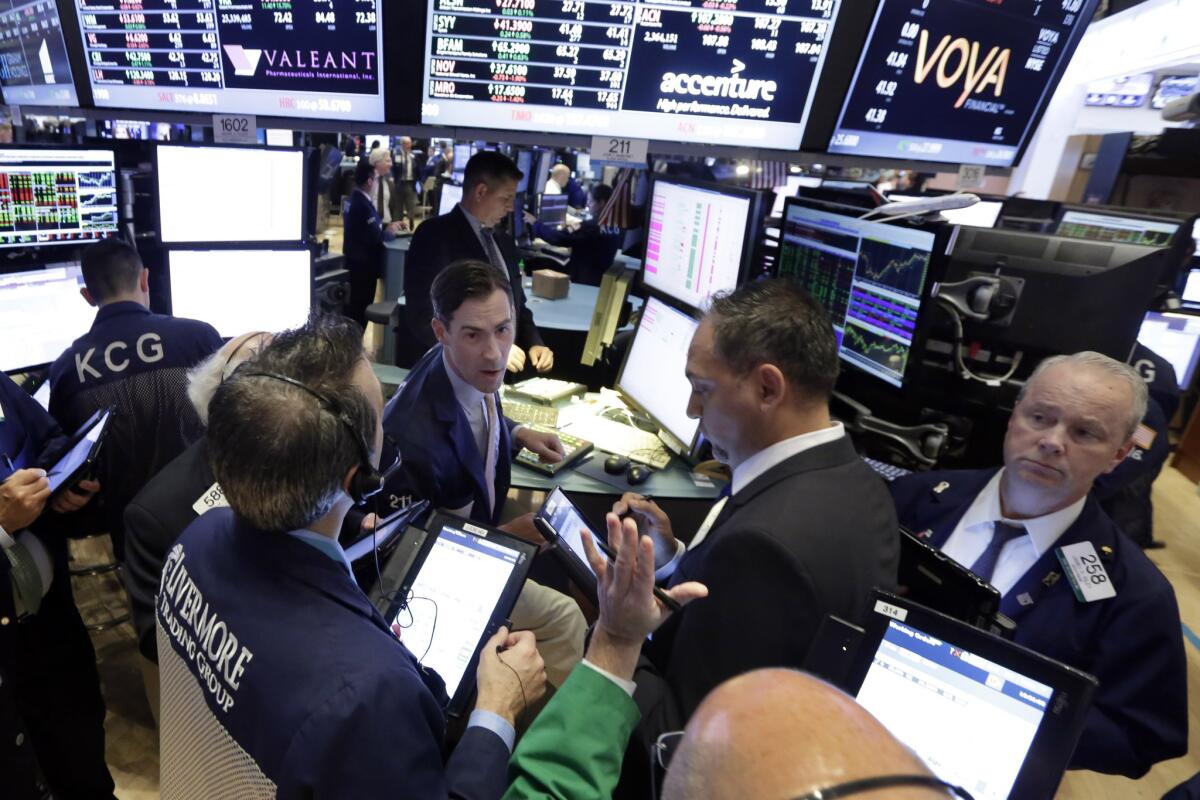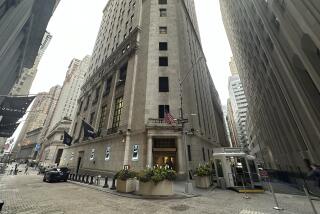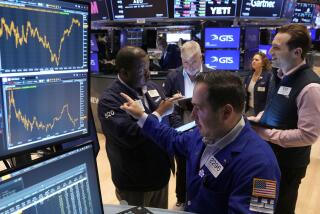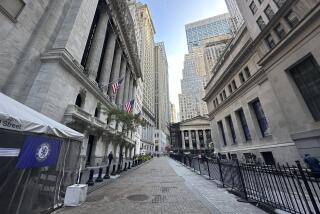Stock markets show resilience despite Paris attacks, other geopolitical risks

The Dow Jones industrial average rose aggressively Monday and registered strong gains this week, as did other major indexes, a marked difference from the aftereffects of many prior tragedies.
REPORTING FROM NEW YORK — Stock markets have been largely uneventful this year, save for the huge drops in August, and they showed through last week’s terrorist attacks in Paris a remarkable characteristic: resilience.
The markets had plenty of reasons to crater even before the horrific attacks added a new layer of geopolitical risk to the financial landscape, but they didn’t.
The Dow Jones industrial average rose aggressively Monday and registered strong gains this week, as did other major indexes, a marked difference from the aftereffects of many prior tragedies. Even European stocks were up.
“When you hear a gunshot, your first instinct is to duck,” said Sam Stovall, U.S. equity strategist for S&P Capital IQ. “This time, we didn’t even duck.”
Stovall noted in a recent report that the broader Standard & Poor’s 500 index suffered at least some sort of drop in the wake of a series of dramatic news events in the modern era, including a two-day drop after the 2005 London subway bombings and the 2004 Madrid bombings that started a seven-day slide.
The longest slide after a market shock was 176 days after the 2008 Lehman Bros. bankruptcy in the fall of 2008, eclipsing even the 143 days after the attack on Pearl Harbor on Dec. 7, 1941.
The Dow’s gain of 91.06 points Friday to 17,823.81 capped a 3.4% rise for the week that put the blue-chip index at break-even for the year. The S&P 500 gained 7.93 to 2,089.17, a 3.3% gain for the week and 1.5% for the year. The tech-oriented Nasdaq composite rose 31.28 points to 5,104.92, a 3.6% weekly gain that left it up 7.8% for the year.
“Most people are surprised at the resilience of the markets and surprised at the consistency of the resiliency,” said Chris Hyzy, chief investment officer for Bank of America’s wealth and investment management unit.
Even the midweek indication that Federal Reserve officials were closer than many analysts thought to raising a key interest rate next month seemed to rally stocks, not depress them as such news had done in the past.
Analysts also noted that oil prices, normally a sensitive barometer of geopolitical risk, barely budged in the wake of the attacks. The price of bellwether West Texas Intermediate crude rose slightly over last weekend, but has fallen 0.9% since Monday to $40.39 a barrel, a sign of confidence to analysts that any international response to the Paris shock would be measured.
“It really hasn’t moved,” John Lonski, chief capital markets economist for Moody’s Analytics, said about the price of oil.
The risks to stocks, though, remain formidable. For one thing, one of the forces keeping oil prices down — a soft global demand — also threatens stocks. Also, economies worldwide are still weak, and some experts question the staying power of U.S. economic growth.
The Organisation for Economic Cooperation and Development recently cut its estimate of global growth for the second time in three months. The organization now expects growth of 2.9% this year and 3.3% next year, the latter down from a previous estimate of 3.6%.
The main worry is emerging markets, starting with China, said Russ Koesterich, global chief investment strategist at investment firm BlackRock Inc. The Asian giant recently reported that exports were down 3.6% from a year earlier and signaled that both inflation and industrial production were decelerating.
The global problems have seeped back into the U.S. economy, pushing down earnings estimates for the S&P 500 by two percentage points over the last five weeks, Koesterich said.
Moreover, the recent spending by the American consumer, which has underpinned U.S. economic growth, may be running out of steam. Goldman Sachs Group Inc. is forecasting that consumer spending growth will slow to 2.5% to 2.75% next year from the current 3% to 3.5% pace, mostly because the income-bolstering effects of lower gas prices is bound to taper off.
Once a looming worry, the possible hike in a key Fed rate doesn’t seem to be hammering markets as it used to.
Liz Ann Sonders, chief investment strategist at Charles Schwab Corp., and others wondered whether the Paris attacks, coupled with recent increases in the dollar and other growth-damping factors, “could lead the Fed to punt yet again.” But a consensus is forming that the so-called liftoff is imminent.
That consensus was spurred by the release Wednesday of the minutes of the last Fed meeting, which showed that policymakers were more inclined than previously thought to raise the rate next month for the first time since June 2006.
The Dow responded that day with a gain of nearly 248 points, or 1.4%
The market’s resilience is no accident, analysts said. Stocks have been buoyed by solid fundamental support that starts with the U.S. recovery, which, despite pauses, remains on track. And there may be some hidden catalysts for an upside surprise.
Bank of America’s Hyzy said that earnings for the S&P 500 were up a fairly robust 6.7% once the struggling energy sector was excluded. He argued that the economy already has suffered the worst effects of oil’s decline and that the benefits are only now taking hold.
For next year, analysts expect reasonable earnings growth for the S&P 500 companies — 1.7% in the first quarter and 4.9% in the second, said Moody’s Lonski, who calls that “good enough.”
And a notable University of Michigan study released Thursday included a forecast for economic growth of 2.6% next year, which would be the fastest pace since 2006, and 2.9% the following year.
Though the forecast is bullish, analysts said the U.S. stock market has one more advantage: few attractive alternatives.
“We’re still considered to be the safest place in the world to put your money to work, so money does flow here,” said Alan Whitman, a Morgan Stanley managing director.
More to Read
Inside the business of entertainment
The Wide Shot brings you news, analysis and insights on everything from streaming wars to production — and what it all means for the future.
You may occasionally receive promotional content from the Los Angeles Times.











